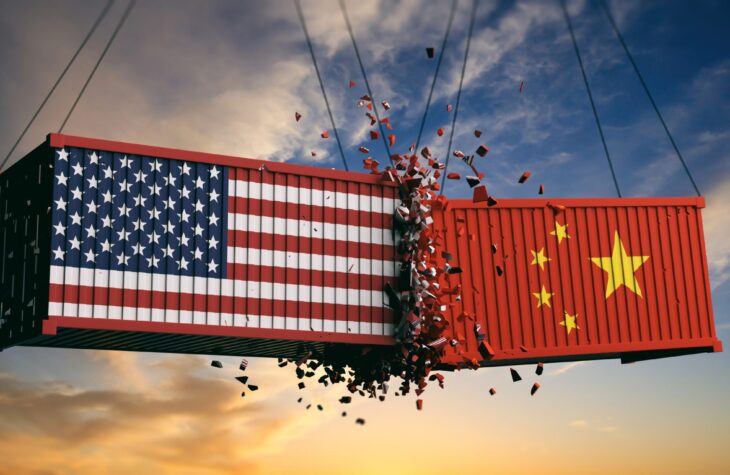
Primer: Removing Tariffs on China Will Not Make America Safer or Prosperous

Introduction
The U.S.-China trade relationship presents many areas of concern demanding the attention of policymakers as evidenced by the significant pre-tariff trade deficit of $418 billion with an adversary, the ongoing economic implications of being so interconnected with the lockdown decisions of a Chinese dictator, and the continued presence of unfair trade practices.
During its tenure, the Trump Administration took dramatic action aimed at addressing those unfair trade practices, including intellectual property theft, coercive requirements, state subsidies, and market access restrictions. At the conclusion of its investigation under Section 301 of the Trade Act of 1974, on July 6, 2018, the U.S. Trade Representative (USTR) imposed 25 percent tariffs on $376 billion in Chinese goods that are set to expire in tranches throughout the end of the year, pending review, if not extended by the Biden Administration.
The repeal of the Section 301 tariffs as a way to address the inflation caused by spending and regulatory policies amounts to little more than a gimmick with grave geopolitical implications for the United States’ relationship with its main adversary, China. The Section 301 tariffs were imposed three years ago, and inflation only occurred under the Biden Administration. These tariffs arose out of an available legal process to review and correct unfair (and still uncorrected) trade practices and gain leverage over China to continue to fight for a more reciprocal trade relationship. And China is a geopolitical adversary that uses the wealth transferred from trade with the U.S. to further its military ambitions at the expense of the U.S. and its allies. As a result, the Biden Administration should extend the Section 301 tariffs on schedule and resist the temptation to use inflation as an excuse to warm the relationship with China.
Section 301 Tariffs on China
Section 301 of the Trade Act of 1974 authorizes USTR to impose duties or tariffs on foreign countries in order to rebalance an unfair trading system at the conclusion of an investigation. On August 14th, 2017, the USTR initiated an investigation into Chinese subversion of American digital commerce, particularly intellectual property theft. Under the Trade Act, conduct that is unreasonable must also present a burden or restrict U.S. commerce to be actionable. The USTR’s investigation focused on four major points of contention: the forced transfer of sensitive intellectual property and technology requirements, discriminatory regulations with respect to technology licensing agreements, the targeted undermining of U.S. technology via China’s outbound investments, and the Chinese government’s support of hacking of U.S. companies to acquire information and data giving itself an edge in global competition.
First, Chinese regulations require foreign companies to transfer or disclose proprietary technology and information to Chinese authorities. Chinese government officials engage in a pattern of closed-door deals which minimized paper trails and limited the ability of businesses to report the illegal coercion to U.S. authorities.
Second, the Chinese government restricts the right of U.S. companies to enter into licensing agreements and subjects foreign companies to two discriminatory regulatory regimes from which Chinese companies are exempted – The Regulations of the Peoples Republic of China on the Administration of the import and export of technology (TIER) and Joint Venture requirements (JV). As a result of these discriminatory regulations, technology licensing agreements are necessarily lopsided to the benefit of China. For example, U.S. companies are required to bear all financial risks in licensing agreements. Article 24 of the TIER Regulations states that the foreign company is liable for any illicit actions, meaning that a U.S. company is liable even if it is the Chinese company that misuses the technology. Additionally, the TIER regulations stipulate that U.S. companies cannot negotiate risk-sharing with Chinese companies. The TIER and JV regulations only apply to foreign investment, are clearly discriminatory against foreign companies, and aim to displace the U.S. in global markets and undermine the competitiveness of the global trading system.
Third, Chinese policies incentivize direct investment in key U.S. sectors. China is actively burrowing into the U.S. technology sector in order to gain and acquire technology and high-skilled labor. These are then transferred to the Chinese government to be used against the U.S.
Fourth, the Chinese government supports corporate espionage. China utilizes cyber-attacks to acquire sensitive data of U.S. companies in order to gain a foothold within sectors critical to Made in China 2025 (MIC 2025), its plan to supercharge its industrial base. MIC 2025 targets ten different areas such as aerospace, information technology, and agriculture machinery which China aims to dominate by 2025. If successful, China would be able to leapfrog other countries and specifically replace U.S. competition in those key sectors. China’s attempts to degrade, reduce, and replace foreign competition in key sectors is a national security threat that U.S. policymakers must address.
At the conclusion of its investigation, USTR found China’s practices were an unjust and burdensome restriction on U.S. commerce and issued 25 percent tariffs on a series of specific goods. List 1 constituted $34 billion in industrial equipment, effective July 2018. List 2 was $16 billion in raw materials including wires and circuits, effective in August 2018. List 3 goods, including certain foods and household items like lawnmowers and calculators, were valued at $200 billion and were effective September 2018. Finally, $126 billion in list 4A goods, which were designed to hit products not already covered and were effective September 2019. In response, China countered with its own set of tariffs on U.S. goods.
The tariffs forced China to the negotiating table resulting in the Phase I Trade Agreement signed by President Trump in 2020. This agreement stated that China would purchase $200 billion in U.S. goods and services, including manufactured goods, energy products, and food. In addition, China also agreed to a host of other provisions, including stronger intellectual property enforcement, elimination of forced technology transfers, agricultural initiatives, and opening of financial services to U.S. businesses.
Four years after the imposition of tariffs, the Trade Act requires the USTR to conduct a review of them. The Biden Administration is conducting that review and will soon make a determination on continuing or repealing the tariffs.
Sec. 301 Tariffs Should be Left in Place
Before the Sec. 301 tariffs, the U.S.-China trade deficit was expanding. In the two years following the tariffs, and before the COVID-19 pandemic, the trade deficit declined by almost $120 billion. That sustained decline has been somewhat disrupted, but as the worldwide economy reopens and trade resumes so would the declining trade deficit. If the administration allows the tariffs to expire, any chance of continuing to reduce the deficit would be significantly hampered. U.S. policymakers should be careful not to assist China by resuming the unfair trading relationship that was the catalyst for the decimation of the American middle class. Not only did the trade deficit grow, but 3.7 million jobs were offshored since China’s admittance to the World Trade Organization (WTO). In addition, expanded trade with China has caused non-college-educated workers to lose upwards of $2,000 per year, according to the Economic Policy Institute.
Americans are experiencing a severe rise in inflation, currently at 9.1 percent, removing the 301 tariffs will not improve this monetary situation. The tariffs were imposed three years ago without a spike in U.S. inflation. A recent report explains that the Sec 301 and 232 tariffs are not inflationary because they make up such a small percentage of personal consumption expenditures, and at most contributed to a 0.1 percent increase in prices, three years ago. Meanwhile, the Federal Reserve of San Francisco said the COVID-19 pandemic-related government spending bills contributed about 3 percent to the current inflation rate. This, in combination with the other bad fiscal policies that the Biden Administration pursued, is the reason inflation is currently at a 40-year high.
With regard to the Phase I Trade Agreement, China is not currently living up to its commitments. The issues caused by the pandemic have only exacerbated the need to decouple from a geopolitical adversary. For example, President Trump had to invoke the Defense Production Act for personal protective equipment and ventilators in March 2020. Over-reliance on Chinese goods has and will continue to cause problems.
Critical minerals are minerals that the U.S. government deems necessary on the basis of national security. The U.S. Department of Interior put out a study that found that the U.S was 100 percent dependent on imports for 17 critical minerals. Further, the U.S. only produces 12 percent of the world’s semiconductors, while Taiwan produces 48 percent. The U.S. must restore its manufacturing base, and the tariffs are necessary as incentives for the rebuilding that is essential to future prosperity.
China’s share of joint venture deals rose 10% between 2010-2015, meaning the Chinese government increased its involvement in foreign business dealings in order to gain access to sensitive data, such as source codes, intellectual property, and proprietary technology. This technology transfer regime is conducted to the detriment of both U.S. companies and the nation as a whole. Tariffs can be used to push back against the advances of adversary nations.
For example, Section 232 of the Trade Expansion Act, similar to the Trade Act of 1974, allows for the imposition of tariffs in response to national security threats. The Trump Administration placed Section 232 tariffs on the steel and aluminum industry in 2018. From the imposition of the tariffs to February 2020, there was a 37.6 percent increase in aluminum production, a clear resurgence. A July 2022 report found that the construction of manufacturing buildings and factories is up 116 percent. Sec. 301 tariffs should be left in place to achieve a similar strategic goal of restoring American industry in order to compete and overcome its geopolitical rivals.
If the Biden Administration removes the tariffs, it also forfeits leverage to combat unfair trade practices. The technology transfer regime will continue unabated. So will its discriminatory licensing regime. Meanwhile, the Chinese face no similar hurdles in their investments in the U.S. The goal for the U.S. should be to push toward reciprocal trade with foreign countries.
Economic strength is a catalyst for an increase in military power. As China continues to take advantage of the U.S. in terms of trade, they are becoming more formidable militarily. Technology and intellectual property transfers are turned around against the U.S. That is the precise goal of MIC 2025.
Conclusion
After China was admitted to the World Trade Organization in 1995, corporations began, and still are, offshoring U.S. jobs en masse, skyrocketing the trade deficit. China is currently our greatest geopolitical foe, and the United States cannot allow them to ransack the U.S. economy by taking jobs and high wages too. The Trump Administration initiated a Sec. 301 investigation in order to turn the tide of abuse. Without the tariffs, China will only become more emboldened and aggressive in its unfair trade practices. President Biden must not let the Sec. 301 tariffs expire, as doing so would be a mistake to the future of the U.S. and the international economy.



